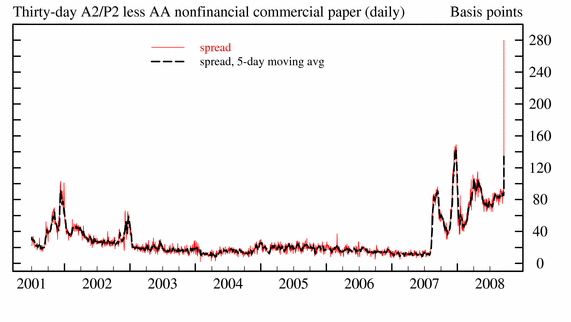Paulson and Bernanke got it wrong on Lehman
FT Alphaville has two posts today that mirror my view on the Lehman Brothers bankruptcy. They basically say it was a huge mistake to let Lehman fail.
Lehman was, in fact, too big to fail and the blow up in the markets since its failure is a direct result of the bankruptcy. Does this mean that we support bailing out investment banks that lose billions of dollars? No.
It means that Hank Paulson, Ben Bernanke and Christopher Cox and their predecessors failed to put enough rigor in the regulatory oversight they provided the likes of Lehman. This is the ultimate reason Lehman failed.
A bailout probably would have avoided the events of last week. And possibly also the need for an RTC II altogether.Lehman’s collapse – like Bear Stearns’ collapse – wasn’t triggered directly by big writedowns on mortgage securities. It was triggered by a slow erosion of confidence that reached its tipping point on Friday 12th September. A point was reached where it didn’t actually matter what the fundamentals of Lehman’s business were, but where clients and creditors were caught in a classic prisoner’s dilemma: everyone feared what everyone else was thinking. The optimal solution was just to cut and run, nevermind altruism.
When Lehman did go under, it was a shock. The CDS on Morgan Stanley and Goldman Sachs were already trading wide, but LEH’s collapse sent them rocketing. There was suddenly a realisation that the Treasury would let banks fail, and therefore – like with Lehman – the only thing really propping them up really was just the confidence of their creditors and their clients. Nevermind, in other words, in the post-LEH world, what the banks were saying about their liquidity facilities or the strength of their numbers: all that matters is the perception of generalised fear in the system.
Which is all very well and philosophical.
But the real knock-on from Lehman’s collapse and why it really did wreak havoc – in a very direct sense – was the quiet failure of Reserve Primary. When that money market fund collapsed because of defaulting Lehman holdings in its portfolio, other money market funds ran for the hills in a rather spectacular way.
Let the systemic importance of the money market funds not go underestimated. Money market mutuals are the main buyers of commercial paper: short-term debt issued by corporations to fund their activities and ensure solvency on a daily, weekly or monthly basis.
Here’s the catastrophe graph, supplied by the Fed (via Calculated Risk):
This is the spread on A2/P2 Non financial commercial paper over AA commercial paper. Unless I’m mistaken, last Thursday’s spread is actually even higher: 359bps.
What the graph shows is an absolutely unprecedented pullback of buying in the short-term debt markets. Money market mutuals have simply stopped touching CP, even if it’s non-financial. Previous dramatic collapses in CP buying have been limited to that issued by financial companies or asset-backed conduits. Non-financial CP is issued by regular corporations the length and breadth of the US. The kind of collapse the above graph shows marks a sea change in the crisis, with far more profound implications for regular “main street” corporations.
Here, by the way, is where some of that spare money-market money went when it left CP. (Money market fund holdings are restricted to short term debt, certificates of deposit and sovereign debt).
From which point of view it would seem as if the U.S. Treasury made – by its own criteria – a big mistake with Lehman: the $400bn backstop for the money market mutuals only came after Reserve Primary broke the buck. It evidently wasn’t an anticipated consequence.
It’s easy playing counterfactual history of course, there are always myriad possibilities in retrospect.
–Blame Lehman, FT Alphaville
For what it’s worth, FT Alphaville points out in a second post today that the ratings agencies downgraded AIG, precipitating its own meltdown, in large measure due to the Lehman collapse.
So, here is more direct evidence that Lehman’s failure had very significant knock-on effects that could have been avoided had Paulson and Bernanke developed a better policy response to the Lehman situation.
AIG might have averted the sharp cuts to its credit ratings that forced it to seek a government bail-out last week if Lehman Brothers had been saved from bankruptcy, according to analysts at credit rating agency S&P. “The Lehman bankruptcy was not the only cause but it was a contributor,” said Rodney Clark, S&P analyst, adding that AIG shares and credit might not have experienced as severe a market reaction if Lehman had not filed for bankruptcy. The downgrades of AIG’s debt last Monday forced the insurer to come up with billions of dollars of collateral payments immediately to pay banks with which it has many derivatives trades outstanding. Its inability to finance the payments, as well as calls for extra collateral related to the declines in the market value of its derivative positions, pushed AIG close to bankruptcy early last week. This, in turn, forced the U.S. government by Tuesday evening to make an $85bn bridging loan in return for a 79.9% equity stake in the troubled company. S&P warned Sept 12 that it might cut AIG’s ratings.
–S&P: Lehman’s demise key to AIG woe, FT Alphaville
The damage is done now. But, it would be nice if we had competent regulatory overseers who knew how to deal with crisis.

Comments are closed.